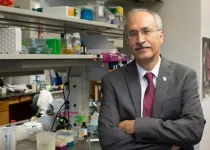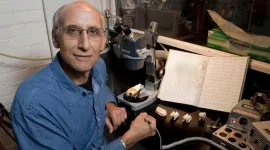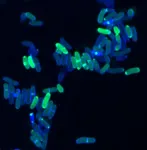(Press-News.org) The relationship between living in a polluted city like São Paulo (Brazil) and lung disease or cancer is well known. But the problems go further. Unprecedented research shows that long-term exposure to air pollution is directly linked to increased heart risks in residents of the capital of the state of the same name. People with high blood pressure are at even greater risk.
The study, published in the journal Environmental Research, was conducted by researchers from the University of São Paulo (USP) with support from FAPESP (projects 13/21728-2, 16/23129-7 and 19/06435-5). The research shows that cardiac fibrosis, an indicator of heart disease, is related to the duration of exposure to black carbon particles, an indicator of air pollution.
The researchers analyzed the autopsies of 238 people and epidemiological data to measure this association. They also interviewed relatives of the victims to gather information on risk factors such as a history of smoking and hypertension. From macroscopic observation of lung tissue, they determined the presence and amount of the black carbon fraction in the lungs. Myocardial samples revealed the cardiac fibrosis fraction.
The results showed a significant association between the black carbon fraction in the lungs and cardiac fibrosis in the individuals studied. This means that the longer a person is exposed to pollution, the more likely they are to develop fibrosis. “This data highlights the crucial role of autopsy in investigating the effects of the urban environment and personal habits in determining diseases,” says one of the authors of the study, pathologist and USP professor Paulo Saldiva.
In addition, it was found that the risk is increased for hypertensive individuals. Among them, the presence of the heart disease marker increases with the increase in the presence of the pollution exposure indicator, both in smokers and non-smokers. Among non-hypertensive individuals, the highest risks were observed mainly among smokers.
Hypertension, or high blood pressure, is a disease that can be silent and without symptoms. According to the Brazilian Ministry of Health, the mortality rate has increased in ten years from 11.8 deaths per 100,000 inhabitants in 2011 to 18.7 in 2021. Around 60% of the country’s elderly suffer from hypertension.
When hypertension is silent, pollution is not always visible. In some cases, however, it is possible to know where it is most harmful. Exposure to pollution within the same city depends on factors such as people’s habits and commutes. “We can say that there are two indicators of pollution, one measured by the CETESB [São Paulo State Environmental Corporation] network, which is objective. And another related to how much each individual is exposed to,” he says. “In other words, the level of concentration of environmental pollution doesn’t mean the same dose is received by everyone. If you’re in a traffic corridor for hours, you receive a higher dose because the concentration of that environment is particularly higher.”
Saldiva explains that various factors, such as hypertension itself, influence the development of cardiac fibrosis, and that pollution has now been shown to be one of them. “The question was, ‘Is pollution big enough to show up in this photo?’ It is, and it was the first time in the world that it had been demonstrated in humans. That’s the difference in this work,” he points out.
According to the doctor, the study was only possible thanks to the work carried out 24 hours a day, 365 days a year by the city’s Death Verification Service (SVO). He says that the support of the USP Medical School and FAPESP, in agreements signed in the past with the SVO, has built up a vast body of processes and information that today lead to new scientific possibilities.
USP’s research provides evidence of the impacts of air pollution on cardiovascular health and highlights the need for effective measures to reduce the population’s exposure to this evil. Implementing measures such as reducing vehicle emissions, promoting sustainable public transport in the city, and promoting clean energy sources are effective strategies for mitigating the impacts of air pollution on public health.
About São Paulo Research Foundation (FAPESP)
The São Paulo Research Foundation (FAPESP) is a public institution with the mission of supporting scientific research in all fields of knowledge by awarding scholarships, fellowships and grants to investigators linked with higher education and research institutions in the State of São Paulo, Brazil. FAPESP is aware that the very best research can only be done by working with the best researchers internationally. Therefore, it has established partnerships with funding agencies, higher education, private companies, and research organizations in other countries known for the quality of their research and has been encouraging scientists funded by its grants to further develop their international collaboration. You can learn more about FAPESP at www.fapesp.br/en and visit FAPESP news agency at www.agencia.fapesp.br/en to keep updated with the latest scientific breakthroughs FAPESP helps achieve through its many programs, awards and research centers. You may also subscribe to FAPESP news agency at http://agencia.fapesp.br/subscribe.
END
Research shows link between pollution and heart risks in residents of the city of São Paulo, Brazil
A study by the University of São Paulo, published in the journal Environmental Research, analyzed the results of the autopsies of 238 people and epidemiological data; the risk is greater for hypertensive patients
2024-04-29
ELSE PRESS RELEASES FROM THIS DATE:
Rice’s Yousif Shamoo elected AAAS fellow
2024-04-29
Rice University bioscientist Yousif Shamoo has been elected a fellow of the American Association for the Advancement of Science (AAAS), the world’s largest general scientific society and publisher of the journal Science.
The lifetime honor, one of the highest in the scientific community, is accorded to fewer than 1% of AAAS members each year. Shamoo, the Ralph and Dorothy Looney Professor in the Department of Biosciences, was recognized “for distinguished contributions to research on multidrug resistance, protein structure ...
Mazin to study electronic, transport & topological properties of frustrated magnets
2024-04-29
Igor Mazin, Professor of Practice for Advanced Studies in Theoretical Physics, Quantum Materials Center, Physics and Astronomy, is set to receive funding for the project: “Electronic, transport and topological properties of frustrated magnets.”
In this project, Mazin and his collaborators will examine frustrated magnetic systems.
Magnetic frustration lies at the core of the notion of skyrmions and quantum spin liquid.
Mazin will receive $258,480 from the National Science Foundation for this project. Funding will begin in May 2024 and will end in late April 2027.
###
ABOUT GEORGE MASON UNIVERSITY
George Mason University is Virginia’s largest ...
TCT 2024 Career Achievement Award to be presented to Robert A. Harrington, MD
2024-04-29
NEW YORK – April 25, 2024 – The TCT® 2024 Career Achievement Award will be presented to Robert A. Harrington, MD, during Transcatheter Cardiovascular Therapeutics® (TCT®), the annual scientific symposium of the Cardiovascular Research Foundation® (CRF®). TCT® will take place October 27-30 2024, in Washington, DC at the Walter E. Washington Convention Center. The award is given each year to an outstanding individual who has made extraordinary contributions to the field of interventional cardiology and has transformed ...
Tibetan plateau had broader social dimensions than previously thought
2024-04-29
The Tibetan plateau—the world’s highest and largest plateau—poses a challenge to the people who live there because of its extreme climate. In a new study, researchers have discovered stone artifacts that suggest that there were more cultural exchanges between those who lived on the plateau and those living on its perimeter.
“The Tibetan plateau has an average elevation of more than 4500 meters, which makes Colorado seem like it is at sea level. It’s amazing that people have been able to occupy this area on and off for at least the last 40,000 years,” said Stanley Ambrose (MME), a professor of anthropology. “Unfortunately, very little ...
Oncotarget sponsors 19th International p53 Workshop in Italy
2024-04-29
Oncotarget is a contributing sponsor at the 19th International p53 Workshop in Trieste, Italy, on May 13–16, 2024.
BUFFALO, NY- April 29, 2024 – Oncotarget is a contributing sponsor at the 19th International p53 Workshop, organized by the International Center for Genetic Engineering and Biotechnology (ICGEB), which takes place from May 13–16, 2024, in Trieste, Italy.
“Groundbreaking research and cutting-edge advancements in the field of the most studied human gene and most frequently mutated gene in cancer, will take center stage at the 19th ...
NYS solar work: Good for climate, but are they good jobs?
2024-04-29
ITHACA, N.Y. -- New York state solar construction workers – whose numbers are expected to grow rapidly to meet climate goals – are transient, may not receive benefits and are subject to racial disparities in pay, finds a new report from the Climate Jobs Institute (CJI) at Cornell University.
“Exploring the Conditions of the New York Solar Workforce” was funded by the New York State Department of Labor and surveyed more than 260 solar installation and maintenance workers. The exploratory study is the first to focus on workers’ experiences, seeking to bridge gaps in government and industry ...
New system boosts efficiency of quantum error correction
2024-04-29
The fragile qubits that make up quantum computers offer a powerful computational tool, yet also present a conundrum: How can engineers create practical, workable quantum systems out of bits that are so easily disturbed — and wiped of data — by tiny changes in their environment?
Engineers have long struggled with how to make quantum computers less error-prone, often by developing ways to detect and correct errors rather than prevent them in the first place. However, many such error-correction schemes involve duplicating information across hundreds or thousands of physical qubits at once, which quickly becomes hard to scale up in an efficient way.
Now, ...
Study suggests staying current with COVID-19 vaccinations helps combat emerging variants
2024-04-29
New research using live SARS-CoV-2 virus reveals an updated vaccine provides a strong immune response against previous strains and emerging variants.
The findings by researchers at Oregon Health & Science University, published in the journal Emerging Infectious Diseases, suggest a clear benefit in receiving updated vaccinations on a regular basis, especially among older people or those with underlying medical conditions.
“The virus is still circulating, it’s continuing to evolve, and it remains dangerous,” said co-senior author Fikadu Tafesse, Ph.D., associate professor of molecular ...
It’s all in the smile: Aston University-led research finds politicians can influence voters with facial expressions
2024-04-29
Dr Carl Senior identified two types of smile – affiliative and reward – given by political leaders during the last UK general election in 2019
The eventual winner, Boris Johnson, was found to display the affiliative smile, which acts to align voter behaviour
The study is the first to look at how supporters of election losers react to the eventual winner.
New research led by Aston University’s Dr Carl Senior has found that the type of smile used by a political leader can influence voters to support them and their political agenda.
There are many different types of smile, and the ...
Possible alternative to antibiotics produced by bacteria
2024-04-29
Many bacteria produce substances to gain an advantage over competitors in their highly competitive natural environment. Researchers at the University Hospital Bonn (UKB), the University of Bonn and the German Center for Infection Research (DZIF) have discovered a new so-called lantibiotic, namely epilancin A37. It is produced by staphylococci that colonize the skin and acts specifically against their main competitors there, the corynebacteria. This specificity is presumably mediated by a very special mechanism of action, which the researchers were able to decipher in detail. ...
LAST 30 PRESS RELEASES:
Australian team discover why quantum computers have memory problems over time
What determines the fate of a T cell?
Candida auris: genetic process revealed which could be treatment target for deadly fungal disease
Groundbreaking discovery turns household plastic recycling into anti-cancer medication
Blocking a key inflammatory pathway improves liver structure and vascular function in cirrhosis, study finds
Continuous spread: Raccoon roundworm detected in nine European countries
HKUST Engineering researchers developed a novel photodetector to enhance the performance of on-chip light monitoring
Strategic river sensors could have forewarned of Texas Camp flood disaster
Drone sampling of whale breath reveals first evidence of potentially deadly virus in Arctic
Roman soldiers defending Hadrian’s Wall infected by parasites, study finds
Pinochet’s prisoners were tormented with music but still found solace in it, a new book reveals
Fertility remains high in rural Tanzania despite access to family planning
AI-assisted device can improve autism care access
Kinetic careers
Uncovering how parasitic plants avoid attacking themselves to improve crop resistance
Nanoparticle vaccine strategy could protect against Ebola and other deadly filoviruses
Study finds brain care score can predict risk of stroke across racial groups
Key lung immune cells can intensify allergic reactions
Do hormones explain why women experience more gut pain?
New materials conduct ions in solids as easily as in liquids
Breakthrough of the Year: Renewable energy begins to eclipse fossil fuel-based sources
LLM use is reshaping scientific enterprise by increasing output, reducing quality and more
Introducing LightGen, a chip for ultra-fast, ultra-efficient generative AI
Astronomers see fireworks from violent collisions around nearby star
ACC/AHA issue new guideline on managing congenital heart disease in adults
Cosmic crash caught on camera
Is talented youth nurtured the wrong way? New study shows: top performers develop differently than assumed
Ants: An untapped resource in the development of antibiotics?
Archaeologists use AI to create prehistoric video game
Mitochondria migrate toward the cell membrane in response to high glucose levels
[Press-News.org] Research shows link between pollution and heart risks in residents of the city of São Paulo, BrazilA study by the University of São Paulo, published in the journal Environmental Research, analyzed the results of the autopsies of 238 people and epidemiological data; the risk is greater for hypertensive patients




